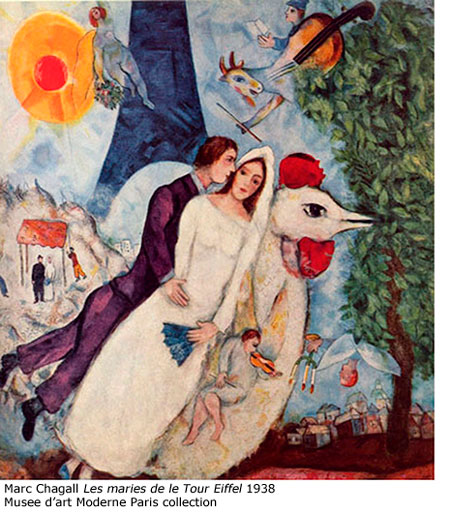Chagall and the Russian Avant-Garde:
ART | REVIEW
Chagall and the Russian Avant-Garde: Masterpieces from the collection of the Centre Pompidou, Paris
The Art Gallery of Ontario is bringing the magic, whimsy and wonder of a Jewish master to Canada in October, writes Sue Smith in her preview of this exhibition.
October 18, 2011 ─ January 15, 2012
Art Gallery of Ontario, Toronto
 "IF I create from the heart, nearly everything works; if from the head, almost nothing."
"IF I create from the heart, nearly everything works; if from the head, almost nothing."
In a major exhibition which opens in October at the Art Gallery of Ontario, the inner world of the Russian poet of Jewish life, love and despair will be on view in paintings never seen before in Canada.
The 118 works in the exhibition will be drawn entirely from the collection of the Musee National d'art Moderne in the Centre Pompidou. The show will feature 32 works by Chagall and eight by Kandinsky, alongside art works by Kasimir Malevich, Natalia Goncharova, Sonia Delaunay and Vladimir Tatlin.
The exhibition aims to examine the influence of Chagall's Russian heritage on his art, and will show how he at turns embraced and rejected avant-garde movements in modern art as he developed his personal style.
The vibrant characters in Chagall's magical paintings reflect the world that bubbled up inside him: his love of wife Bella, music, theatre and his memories of Jewish tradition.
Neither dull reality nor the laws of gravity apply to the people and objects in these works.
"Les maries de le Tour Eiffel" (1938) shows the artist with rubbery, bendy legs, tenderly holding his wistful bride as they fly through the air on the back of a cockerel.
The couple drifts through a landscape which merges Jewish village life and Paris's Eiffel Tower - the one backdrop the lifelong inspiration for his art; the other the arena where he would become intimate with the modern world of Fauvism and Cubism.
Angels and a goat-musician play violins, while another holds the Jewish Tora and the bridal couple is blessed in the rites of his faith. It is all held together with the dissolving contours of Cubist design and brilliant veils of atmospheric colour.
 Chagall was born the first of ten children of poor and illiterate parents in the Jewish quarter of Vitebsk in the western region of Russia known as the Pale.
Chagall was born the first of ten children of poor and illiterate parents in the Jewish quarter of Vitebsk in the western region of Russia known as the Pale.
In his book My Life, Chagall describes his father, a simple, kindly soul, who worked in a herring depot, the vivacity of his eight sisters and the eccentricity of his uncles - Zussy, a hairdresser who curled his whiskers and Neuch, who carried cattle in a jolting trap and played the violin (surely the precursor of all the violonists, on and off roofs, who feature in Chagall's works?)
Thanks to his mother who bribed a teacher at a state school, Marc Chagall escaped this cloistered Jewish world, learnt to speak Russian instead of Yiddish and eventually made contact with the bourgeois, cosmopolitan society in St Petersburg.
In 1910, Chagall went to Paris where he became friends with other expressionists like Modigliani and Soutine as well as Leger and Delaunay.
It was in Paris, as he said, that he "washed his eyes": he learned the principles of geometric construction in the organisation of a picture employed by the Cubists around him.
But whereas Picasso and Gris interpreted objects such as a guitar or a pipe in their essence, Chagall always described the images of his imagination and memory.
In an interview in 1944, Chagall confirmed the intuitive basis of his art: "I am against the terms ‘fantasy' and symbolism'," he said. "All our interior world is reality ─ and that perhaps more so than our apparent world. To call everything that appears illogical, ‘fantasy', fairy-tale or chimera, would be practically to admit not understanding nature."
Bella, the artist's devoted wife, accountant and muse, died in New York in 1944 of pneumonia. Chagall lived on for another four decades, dying in France in 1985.
The critic Robert Hughes described him as "the quintessential Jewish artist of the twentieth century."
Related and Recommended Reading:
